
The Gotha G.I was a bomber aircraft used by the Luftstreitkräfte during the First World War.

The AEG G.IV was a biplane bomber aircraft designed and produced by the German aircraft manufacturer Allgemeine Elektrizitäts-Gesellschaft. It saw action during the First World War with the Luftstreitkräfte.

The Albatros C.III was a twin-seat general-purpose biplane designed and produced by the German aircraft manufacturer Albatros Flugzeugwerke. It was produced in greater numbers than any other C-type aircraft by Albatros as well as being the company's most-produced twin-seat aircraft.

The Albatros B.II, was an unarmed two-seat reconnaissance biplane designed and produced by the German aircraft manufacturer Albatros Flugzeugwerke. It was the aircraft that brought Albatros Flugzeugwerke to the world's attention.
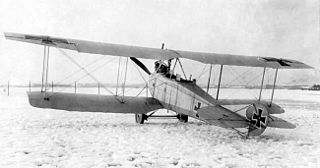
The Aviatik C.I was an observation aircraft designed and produced by the German aircraft manufacturer Aviatik. It was the first aircraft produced by the company to be mass-produced as well as one of the first German military aircraft of the First World War to become fairly well known amongst the general public of the era.

The Albatros W.4 was a military floatplane designed and produced by the German aircraft manufacturer Albatros Flugzeugwerke.
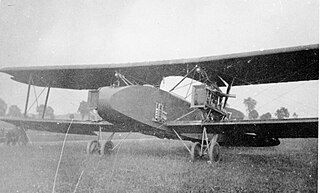
The Albatros G.III, was a German bomber aircraft development of World War I. It was a large, single-bay biplane of unequal span and unstaggered wings. Power was provided by two Benz Bz.IVa pusher engines installed in nacelles carried between the wings. An unusual feature of the design was that the lower wing was provided with cutouts for the propellers, allowing the engine nacelles to be mounted further forward than would have been otherwise possible. Few were built, these seeing service mostly on the Macedonian Front in 1917.

The Albatros J.II was a German single-engine, single-seat, biplane ground-attack aircraft of World War I.

The Friedrichshafen G.I was a prototype heavy bomber aircraft that was built in Germany by Flugzeugbau Friedrichshafen in 1915. It was Karl Gehlen's first design for the company, and although it was not produced in quantity, it provided the foundation for the later, highly successful bombers culminating in the G.III.

The Friedrichshafen G.II was a heavy bomber aircraft that was designed and manufactured in Germany during World War I by Flugzeugbau Friedrichshafen. The plane was used by the Luftstreitkräfte for tactical and limited strategic bombing operations.
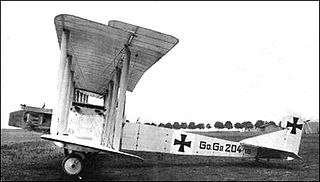
The Gotha G.II series was a heavy bomber used by the Luftstreitkräfte during World War I.
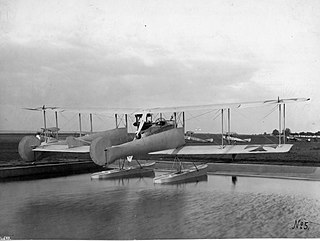
The Gotha WD.3 was a prototype maritime reconnaissance floatplane developed during World War I by Gothaer Waggonfabrik (Gotha) for the Imperial German Navy's Naval Air Service. The three-seat aircraft used the pusher configuration with the engine behind the crew. It was lacking in performance compared to aircraft with the more common tractor configuration with the engine in the nose and was not approved for production. The single prototype completed was used as a training aircraft; its ultimate fate is unknown.

The Gotha WD.7 was a twin-engine maritime patrol floatplane developed during World War I by Gothaer Waggonfabrik (Gotha) for the Imperial German Navy's Naval Air Service. The prototype was captured by the French on its first combat mission in April 1916 after it was forced to make an emergency landing after an engine failed. Despite this seven additional WD.7s were ordered and were used for training torpedo bomber pilots and for trials. Only a single aircraft is known to have survived the war.

The Hansa-Brandenburg GW was a floatplane torpedo bomber produced in Germany during World War I for the Imperial German Navy. In configuration, it was similar to the Hansa-Brandenburg G.I land-based bomber, but the GW was substantially larger and heavier. Like the G.I, it was a conventional three-bay biplane design with staggered wings with the lower wing of slightly greater span than the upper. The undercarriage consisted of twin floats, each mounted on a separate truss structure, leaving space between them for a single torpedo to be dropped from the underside of the fuselage. The metal trusses that had attached the engines to the sides of the G.I's fuselage were not present in this design, with the engine nacelles carried on struts in the interplane gap.

The Rumpler G.I was a bomber aircraft produced in Germany during World War I, together with refined versions known as the G.II and G.III.

The Daimler G.I, originally designated Daimler R.I, was a bomber aircraft designed and built in Germany from early in 1915.

The Albatros G.I was a four-engined German biplane bomber of World War I.

The LVG G.III was a large, twin engine triplane bomber built in Germany near the end of World War I. Only one was completed.

The Schütte-Lanz G.I was a large, twin engine, pusher configuration, experimental biplane built in Germany early in World War I. Only one was completed.
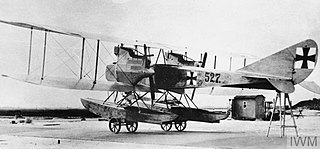
The Albatros W.3, company designation VT, was a biplane torpedo bomber floatplane prototype, built for the Imperial German Navy during the First World War. Only one was built.




















